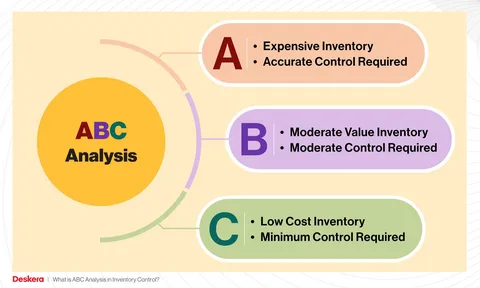ABC inventory, also known as ABC analysis or ABC classification, is a widely-used strategy in supply chain management and inventory control. Its fundamental principle involves categorizing items into three distinct groups – A, B, and C – based on their significance and value to the organization. By doing so, ABC inventory management enables companies to allocate their resources, time, and attention more efficiently, ultimately leading to improved operational efficiency and profitability.
Overview of ABC Inventory Classification
- A Items: These items are deemed the most critical and valuable in the inventory. While they may represent a relatively small percentage of the total inventory count, they contribute significantly to the overall value. Managing A items requires meticulous attention and frequent monitoring due to their substantial impact on the company’s profitability and success.
- B Items: Items classified as B typically hold moderate importance within the inventory. They are more numerous than A items but less than C items. B items have a moderate impact on the total inventory value and profitability. While they require attention and supervision, the level of control needed is less stringent compared to A items.
- C Items: C items are the least important in the inventory hierarchy. Although they constitute a significant portion of the inventory count, their individual value is relatively low. As such, C items have minimal impact on the company’s profitability and are often managed with less detail and attention compared to A and B items.
How ABC Management Works?
**1. Data Collection**: The process begins with collecting relevant data for each product in the inventory. This data may include factors such as product usage, annual sales value, cost, profit margin, and other pertinent measures.
- Criteria Selection: Once the data is gathered, specific criteria are selected to classify products into the A, B, and C categories. Common criteria include annual sales value, frequency of use, and profit margin. These criteria are chosen based on their relevance to the organization’s objectives and operational requirements.
- Classification: Products are then sorted and classified into the respective categories based on the selected criteria. For example, products with the highest annual sales value may be categorized as A items, while those with lower sales value but still significant may be classified as B items. The remaining products with relatively lower value are categorized as C items.
- Inventory Strategies: Different inventory management strategies are implemented for each category to optimize resource allocation and control. A items, being the most critical, require tighter control and more frequent monitoring to ensure their availability. B items, while important, may require less stringent control measures. C items, being the least critical, are managed with minimal attention and resources.
- Regular Review: It’s essential to regularly review and update the classification of products to reflect changes in market conditions, product performance, or business priorities. This ensures that the inventory management strategies remain aligned with the company’s objectives and requirements.
Advantages of ABC Inventory Management
- Efficient Allocation of Resources: ABC analysis allows companies to allocate their resources more efficiently by focusing their attention and resources on the most critical products (A items) while dedicating fewer resources to less important ones (B and C items).
- Cost Reduction: By optimizing inventory levels for each category, ABC inventory management helps reduce transportation, storage, and capital costs. For example, A items may require higher safety margins, while C items may be kept at minimal levels, resulting in overall cost savings.
- Better Inventory Management: ABC analysis improves inventory management by enabling companies to closely monitor and control their most critical products (A items). This reduces the likelihood of stockouts and better aligns inventory levels with customer demand, leading to improved customer satisfaction and operational efficiency.
- Improved Decision Making: The classification provided by ABC analysis offers valuable insights for informed decision-making regarding reorder points, reorder quantities, and inventory levels. This data-driven approach helps optimize inventory management processes and enhances overall decision-making effectiveness.
- Focus on Profitability: ABC inventory management emphasizes maximizing returns on the most productive products (A items) by allocating resources and attention accordingly. By focusing on the most critical products, companies can enhance their profitability and competitiveness in the market.
- Risk Reduction: By closely monitoring and managing A items, companies can mitigate the risks associated with stockouts of critical and high-demand products. This helps maintain customer satisfaction and prevents potential loss of sales, thereby reducing overall business risk.
Conclusion
ABC inventory management is a powerful strategy that enables companies to optimize resource allocation, reduce costs, improve inventory management, and enhance decision-making processes. By categorizing products based on their importance and value, companies can streamline their operations, improve efficiency, and ultimately achieve greater success in their supply chain management endeavors. By implementing ABC inventory management principles, companies can position themselves for sustainable growth and profitability in today’s competitive business landscape.










